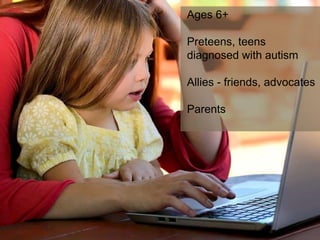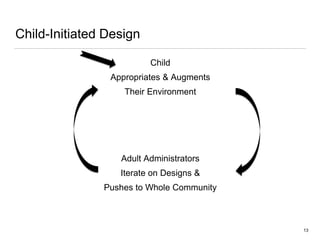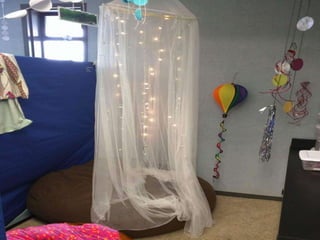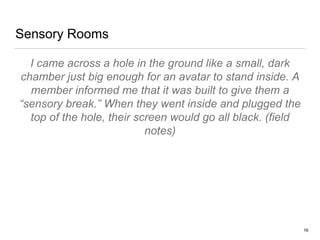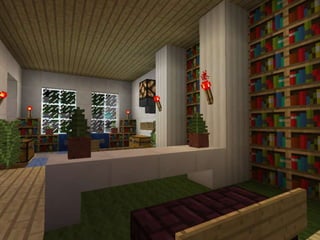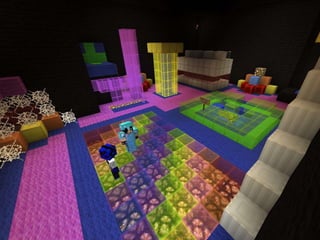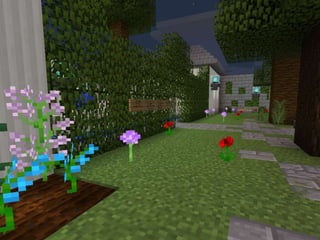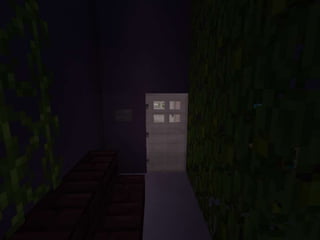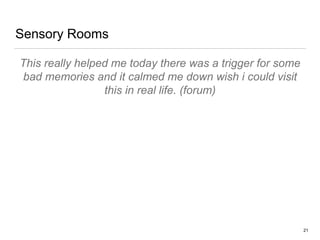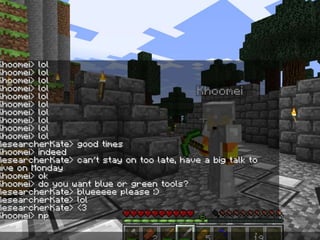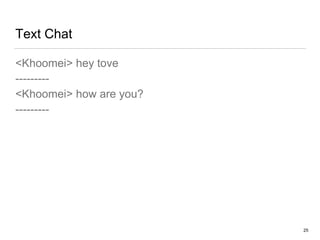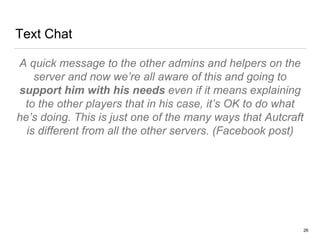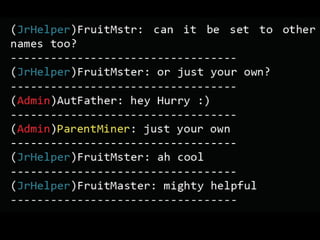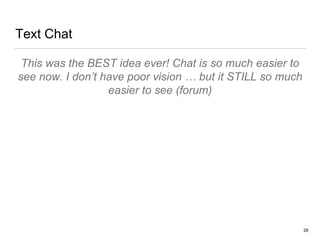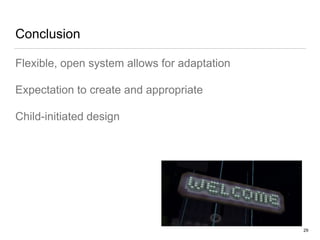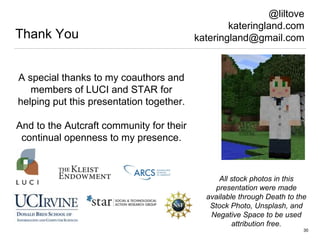Would You Be Mine: Appropriating Minecraft as an Assistive Technology for Youth with Autism
- 1. Would You Be Mine: Appropriating Minecraft as an Assistive Technology for Youth with Autism Kathryn E. Ringland, Christine T. Wolf, LouAnne E. Boyd, Mark S. Baldwin, & Gillian R. Hayes Department of Informatics University of California, Irvine {kringlan, wolfct, boydl, baldwinm, hayesg}@uci.edu ACCESS PDF of SLIDES: bit.ly/minecraftATassets
- 2. Introduction 2 Adoption of assistive technology
- 3. 3
- 4. Research Question How does an online community for children with autism adopt and adapt mainstream information and communication systems (such as Minecraft) as assistive technology? 4
- 5. Autcraft 5
- 6. 6
- 10. Autcraft â[the] first Minecraft server dedicated to providing a safe, fun and learning environment for children on the autism spectrum and their familiesâ (Autcraft website) 10
- 11. Demographics 11 Ages 6+ Preteens, teens diagnosed with autism Allies - friends, advocates Parents
- 12. Analysis 12
- 13. Child-Initiated Design Child Appropriates & Augments Their Environment 13 Adult Administrators Iterate on Designs & Pushes to Whole Community
- 15. Sensory Rooms 15
- 16. Sensory Rooms I came across a hole in the ground like a small, dark chamber just big enough for an avatar to stand inside. A member informed me that it was built to give them a âsensory break.â When they went inside and plugged the top of the hole, their screen would go all black. (field notes) 16
- 17. Discussion 17
- 18. Self Regulation â Sensory Rooms 18
- 19. Self Regulation â Sensory Rooms 19
- 20. Self Regulation â Sensory Rooms 20
- 21. Sensory Rooms This really helped me today there was a trigger for some bad memories and it calmed me down wish i could visit this in real life. (forum) 21
- 22. Sensory Rooms I think sensory rooms are a fantastic idea. And I added a book in calm room 1 its about what to do and about calm rooms. (forum) 22
- 25. Text Chat <Khoomei> hey tove --------- <Khoomei> how are you? --------- 25
- 26. Text Chat A quick message to the other admins and helpers on the server and now weâre all aware of this and going to support him with his needs even if it means explaining to the other players that in his case, itâs OK to do what heâs doing. This is just one of the many ways that Autcraft is different from all the other servers. (Facebook post) 26
- 27. Text Chat Text chat modification 27
- 28. Text Chat This was the BEST idea ever! Chat is so much easier to see now. I donât have poor vision âĶ but it STILL so much easier to see (forum) 28
- 29. Conclusion Flexible, open system allows for adaptation Expectation to create and appropriate Child-initiated design 29
- 30. Thank You 30 @liltove kateringland.com kateringland@gmail.com A special thanks to my coauthors and members of LUCI and STAR for helping put this presentation together. And to the Autcraft community for their continual openness to my presence. All stock photos in this presentation were made available through Death to the Stock Photo, Unsplash, and Negative Space to be used attribution free.
Editor's Notes
- #2: Today I will be discussing how one community for children with autism has appropriated the popular Minecraft game and created a virtual world that also acts as assistive technology.
- #3: As researchers and designers of assistive technology, one of our concerns is adoption. Adoption of assistive tech can be problematic because largeĖýproprietaryĖýsystems are expensive, difficult to manage and therefore often get abandoned.
- #4: Researchers have looked at how mainstream technology might be used as assistive technology. As the hammer in this picture invokes thoughts of DIY activities. Adapting mainstream technology has the benefits being the lower cost, less stigmatized, and more generally available. ThereĖýhaveĖýbeen calls to help empower disabled users by giving them the means and support to hack off the shelf commercial products to make customized, usable assistive devices. The flexibility that comes from allowing users to hack or DIY their own equipment allows for a variety of abilities both for a single user and throughout a community of users.
- #5: To this end, the research question we sought to answer with this paper is:
- #6: Today I will be looking at the Autcraft community, which uses a variety of sociotechnical tools including a specially built Minecraft virtual world.
- #7: Sort of like virtual legos, Minecraft is a customizable, open-ended, creative space. Players can dig up blocks within the virtual worldâthe entire world is made up of these blocks that are randomly generated at world creation. Blocks and materials harvested in the world can then be crafted into objects, technology, or placed back in the world as the player wishes. Construction materials can be created to build house, castles, or whatever the player can think of. Minecraft is easy to use, even for the novice user. It does not require programming skills to create things, unlike other virtual worlds like Second Life. So the learning curve is a little less steep. This makes it especially great for younger children. There is already infrastructure in place for in-world socializing, such as text chat and avatar interactions.
- #8: Users interact in the Minecraft virtual world using avatars. In this picture on the slide, I show my own avatar, dressed in a white lab coat. Using a simple software program, like Paint, you can edit your avatar to look like whatever you like. You can look similar to your physical world appearance or you can not look human at all.
- #9: Here, this user chose to be blue, with large black eyes and a glass helm over her head.
- #10: I will now give a quick overview of my methods while conducting this work. This work is part of an on-going digital ethnography in a Minecraft virtual world, Autcraft. My work to date includes approximately 80 hours of in-world participant observation since the spring of 2014 as well as participating in in-world chat and community forum posts.
- #11: Autcraft is the first Minecraft server dedicated to providing a safe, fun learning environment for children on the autism spectrum and their families. It is run completely by parent volunteers and is sustained from donations by community members. The server welcomes children with autism, their family and friends.
- #12: Participants are mainly pre-teens who have been diagnosed with autism or similar neurodevelopment disorder, but Autcraft also includes adults with autism and children as young as 6. As shown in the image on the screen, younger children often co-play with a parent. Siblings may also share an account, taking turns within the Minecraft virtual world.ĖýAutcraft currently has more than 7,000 whitelisted or âapprovedâ players. One rule of the server is that everyone speak Englishâhowever, users come from all over the globe, with large groups from North America, the UK, and Australia.
- #13: In addition to taking field notes while in-world, I have also conducted interview with parents and children within the Autcraft community. Also, in order to get a full picture of the Autcraft community, I also analyzed data collected from the Autcraft website and forums, Facebook, Twitter, and Twitch. To analyze my data, I used an inductive approach, memoing and coding to find themes within the data and comparing them to that of my co authors.
- #14: In the Autcraft community we found that much of the modification of the virtual world happened in a cycle. First a child would augment their own play space within the virtual world. Minecraft is particularly conducive to this because the whole world is made to be reconstructed. Adult administrators then take notice of what the children are modifying and why they are changing specific things. When an augmentation seems particularly useful, the administrators then work to make the modifications available to everyone in the world. This is done in a variety of ways both by modifying the social rules of the community as well as modifying the software used to run Minecraft. Children then play in the newly modified play space, modifying it again, and the cycle continues.
- #15: Now I will discuss two of the cases from our results that highlight howĖýadministratorsĖýobserved child-initiated designs with the Minecraft virtual world and then implemented those designs across the system.
- #16: Individuals with autism often experience sensory processing challenges. Sights, sounds, or touch sensations may become overwhelming, for instance. Therapy for Sensory Processing Disorders can include a multisensory environment. These are rooms full of different lights, sounds, textures that help calm the user. Each sensory environment is tailored for individual use.
- #17: One community member I came across had created their own sensory break within the virtual world. <READ QUOTE> What is interesting about this is that when the child is feeling overwhelmed, instead of choosing to leave the virtual world or simply turn off their monitor, they are using their avatar within the virtual world to create that dark space for them. The effect is similar, but the child still stays engaged with the virtual world in other ways.
- #18: Administrators also took note of this behavior and chose to create permanent sensory rooms in the virtual world that members can teleport to at anytime. These rooms took on the appearance of calm spaces within the physical world. The picture on the slide shows one of the sensory rooms that takes on the appearance of a library, where a community member can go to sit peacefully away from the activity and chatter of the server.
- #19: One room mimics a multisensory environment commonly used in schools and therapy offices with bright colored blocks and different looking textures.
- #20: Another is a calm garden with flowers and trees.
- #21: The third is a place where the avatar can go into a room, close the door, and experience almost complete darkness much like the hole the child had dug for themselves.
- #22: Now many of the community members could benefit from the sensory rooms and many took to the forums to discuss how helpful they were. Some even commented they wished they had one in the physical world.
- #23: After the sensory rooms were built for general access in Autcraft, the children began adding to and augmenting the space.
- #24: In my second example, a child in the community modified their technology use in order to solve a problem and again the administrators then iterated on the initial augmentation to create a global tool for everyone within the Minecraft virtual world.
- #25: Text chat is the main way community members communicate within the virtual world. Here on screen is an example of what the text might look like as it is scrolling by on the screen. The text box is overlayed on top of the graphics of the world. The font is all white and the lines are spaced fairly close together. If there are a number of people online, as there often are on the Autcraft world, then the text moves off the screen very quickly.
- #26: One child began seperating the lines of their text with symbols such as the dash. They explained to the administrators that they were beginning to lose their vision but still wanted to participate in chat. Adding the dashes to break up the text made it easier to see what was written on the screen.
- #27: This type of repeating the same character over and over is normally against the rules in the Autcraft community because it is like spamming the chat. However, In response, first Autcraft administrators posted to the forums and facebook and explained why this one individual was allowed to break the rules. <READ QUOTE> They wanted all the other community members to know that this particular child was given permission to make these alterations to their text and also to let the other children understand why such a modification might be necessary.
- #28: A software developer in the community saw the facebook post and decided to offer his services to add a modification to the virtual world to help automatically break up the text in the chat. While they were at it, they also added the option to change the colors of the text in order to make the chat easier to read.
- #29: The modifications were made available across the virtual world and ended up helping many more community members than those with visual impairments. <READ QUOTE>
- #30: As the children worked within the confines of the virtual world to make their environment more usable by appropriating with what was available to them, administrators are able to then iterate on these appropriated instances to re-appropriate the software itself. Both the DIY in movement in assistive technology and the practice of modifying game software have set the stage for the Autcraft community to make the kinds of changes to their virtual world that they needed. And even while children with autism are doubly disempowered both because they are children and because they are living with autism, the practice of being able to take some control and appropriate their play space is an empowering one. The flexibility and openness of both the environment within the virtual world and the software itself allows and even encourages this behavior. In summary, this work highlights the ways in which we as researchers who are concerned with accessible and equitable computing spaces might reevaluate our scope of inquiry and how designers might encourage and support appropriation. The appropriations and adaptations we observed in Autcraft point to a future model where child-initiated modifications can guide research and design, providing greater access for disempowered communities.
- #31: Thank you and at this time I am happy to take questions.
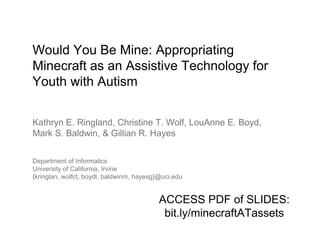
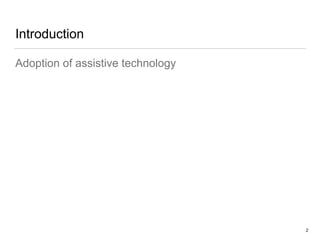
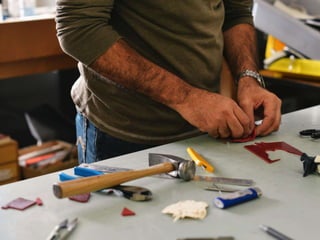
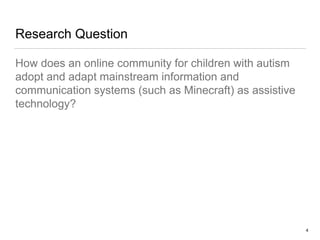
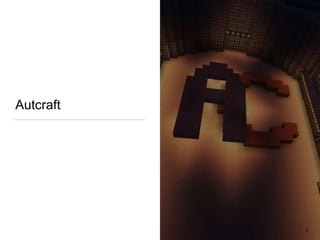
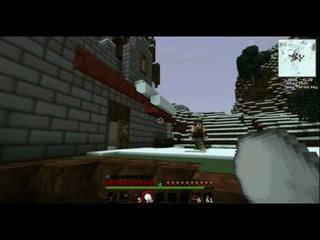
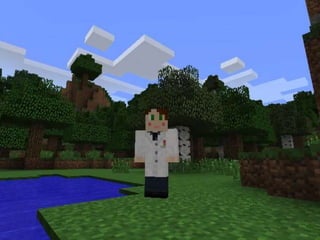
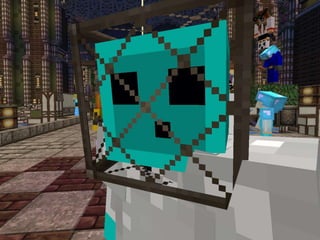
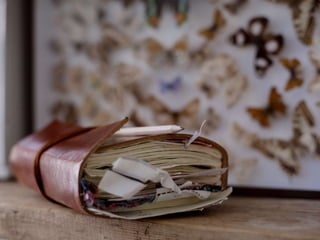
![Autcraft
â[the] first Minecraft server dedicated to providing a
safe, fun and learning environment for children on
the autism spectrum and their familiesâ (Autcraft
website)
10](https://image.slidesharecdn.com/assets2016minecraftappropriation-161024233515/85/Would-You-Be-Mine-Appropriating-Minecraft-as-an-Assistive-Technology-for-Youth-with-Autism-10-320.jpg)
